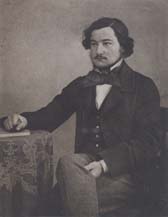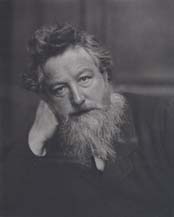

William Morris, poet, artist, craftsman, and political activist, was born in Walthamstow,
Essex, on March 24, 1834. He was the son of William and Emma (née Shelton) Morris, whose
affluence was enhanced by successful speculation in the 1840s in a British copper-mining
endeavor. The fruits of this investment formed the basis for the younger Morris's inheritance,
which provided him with the means to pursue a lifelong search for the ideal in art and life.
 After enjoying a
comfortable childhood, Morris's formal education began. This included
preparatory school at Marlborough College and private tutoring, both of which developed his
interest in history and the Classics. Young Morris matriculated at Exeter College, Oxford, in
January 1853, with the intention of studying for the Church.
After enjoying a
comfortable childhood, Morris's formal education began. This included
preparatory school at Marlborough College and private tutoring, both of which developed his
interest in history and the Classics. Young Morris matriculated at Exeter College, Oxford, in
January 1853, with the intention of studying for the Church.
The idea of taking holy orders fell by the wayside as Morris's horizons expanded and he became exposed to the art criticism of John Ruskin (1819-1900) and the social criticism of Thomas Carlyle (1795-1881). Ruskin's seminal masterpiece, The Stones of Venice (1851), in its reverence for the medieval, presents the Gothic aesthetic as the paragon of beauty. Particularly in the case of architecture, Ruskin writes of the beautiful and artful as being interwoven within the fabric of daily life, not reserved for the hallowed halls of the museum or the homes of the wealthy and aristocratic. This philosophy was embraced and applied by Morris in the creation of his crafts, writings, and books. Carlyle's vehement denunciation of the effects of the Industrial Revolution on the English people and the crass materialism and capitalistic tendencies of the bourgeoisie was also absorbed by Morris. Especially in works such as Past and Present (1843), Carlyle's socialistic tendencies point to Morris's social concerns and his later involvement in the Democratic Federation and the founding of the Socialist League and the Hammersmith Socialist Society.
While at Oxford, Morris met artist Edward Burne-Jones (1833-1898), and an intimate and lifelong friendship began. Together they traveled in Europe, and by 1857 they became seduced by the beauty and philosophy of the Pre-Raphaelite Brotherhood. The Pre-Raphaelites, formed in 1847, espoused the grace, naturalism, simplicity, and romanticism which they saw as integral to the creative output of the Late Gothic and Early Renaissance periods, before the intellectual classicism of the High Renaissance exemplified by the works of Raphael (1483-1520). The key figures in the original Brotherhood were Dante Gabriel Rossetti (1828-1882), William Holman Hunt (1827-1910), and John Millais (1829-1896).
Rossetti cast the most influence over the others, and this arrangement continued when
the first Pre-Raphaelite Brotherhood dispersed and a second group of artists and writers
gathered around him, attracted again by his charm, charisma, and vision. Of this group, it was
Burne-Jones who continued the stylistic tendencies of Rossetti, extending the Pre-Raphaelite
period of painting. And it was Morris who found expression for Pre-Raphaelite Brotherhood values in poetry and crafts.
values in poetry and crafts.
Dante Gabriel Rossetti. The Daydream. Oil on canvas, 1880. Reproduced as the frontispiece for Lucien Pissarro's Rossetti. London: T.C. & E.C. Jack, ca.1908.
Rossetti and Burne-Jones first recognized Jane Burden’s features as epitomizing the romantic Pre-Raphaelite ideal of feminine beauty and, consequently, her potential as a model. But it was Morris who married her in 1859. Jane's beauty appealed to Morris's aesthetic sensibility, while her working class background appealed to his belief in the ideal of a classless, egalitarian society. These attractions, however, failed to sustain a harmonious marriage. Despite rearing two daughters, Jenny (1861-1935) and May (1862-1938), the relationship was riddled with infidelity and unhappiness. Most notable was the distress caused by Jane's affairs with Rossetti and the poet, adventurer, and wealthy radical, Wilfred Scawen Blunt (1840-1922). This painting is a late example of one of Rossetti's many renderings of Jane in the moody, romantic, Pre-Raphaelite mode.
Upon leaving Oxford in 1856, Morris began an apprenticeship with the well-known
Gothic Revival architect, George Edmund Street (1824-1881). Although he stay
ed for almost a
year, the pull of Rossetti was too great, and he became convinced that he should join Burne-
Jones in London in order to pursue the life of a painter. As whimsical as it may sound, it was
their difficulties in finding aesthetically pleasing yet functional furniture for their new home at
17 Red Lion Square which led Morris and Burne-Jones to enlist architect Philip Webb (1831-
1915) to design some pieces, while Rossetti was called upon to collaborate on medieval
decorative motifs. This marked the beginning of Morris’s career in the decorative arts.
George Edmund Street (1824-1881). Although he stay
ed for almost a
year, the pull of Rossetti was too great, and he became convinced that he should join Burne-
Jones in London in order to pursue the life of a painter. As whimsical as it may sound, it was
their difficulties in finding aesthetically pleasing yet functional furniture for their new home at
17 Red Lion Square which led Morris and Burne-Jones to enlist architect Philip Webb (1831-
1915) to design some pieces, while Rossetti was called upon to collaborate on medieval
decorative motifs. This marked the beginning of Morris’s career in the decorative arts.
The group that gathered at Red Lion Square was in large part the same as those who participated in the design and construction of Morris’s Red House at Upton, Kent. Philip Webb designed the very un-Victorian structure, which, in the pursuit of ideal furnishings, gave birth to Morris, Marshall, Faulkner & Co. “The Firm” was Morris’s answer to providing finely made, visually pleasing, functional, and, in theory, affordable furnishings .
The decades of the 1860s and 1870s saw Morris at his most active in writing and
translating , in developing the business of “The Firm,” and in studying and creating illuminated
manuscripts in an attempt to revive the art of calligraphy. The 1870s also saw Morris become a
public activist for both cultural and social causes. He helped found the Society for the
Protection of Ancient Buildings to stave off ruinous restoration or outright destruction of early
English buildings. Morris became a leader of the Eastern Question Association,  formed to
protest Turkish treatment of Christian minorities in their European provinces, and in 1883, he
joined the Democratic Federation, followed by memberships in various branches of the socialist
movement.
formed to
protest Turkish treatment of Christian minorities in their European provinces, and in 1883, he
joined the Democratic Federation, followed by memberships in various branches of the socialist
movement.
The final years of Morris’s full life were devoted to the revival of fine printing. His lifelong love of books and interest in typography combined with fellow socialist Emery Walker’s knowledge of printing gave birth to his beloved Kelmscott Press in 1891. The Press issued fifty- three books which were the culmination of Morris’s constant pursuit of the ideal. The last few years of his life were plagued by exhaustion, diabetes, tuberculosis, and finally kidney failure. He died in London on October 3, 1896. But, as George Bernard Shaw wrote several days later, “You can lose a man like that by your own death, but not by his. And so, until then, let us rejoice in him.”
| INTRODUCTION | WRITINGS | SOCIALISM | KELMSCOTT |